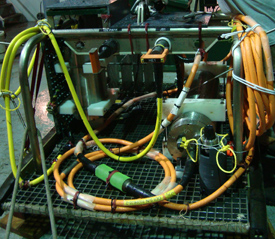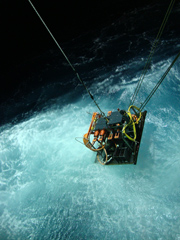Junction Box

The Junction box - J-Box for short - is where all cables come to a junction. One side of the junction box is connected to land through a retired telephone cable. The other side is connected to the instruments of the ACO. Between the instruments and land, it is the task of the J-Box to translate oceanographic language into fiber-optic language that the telephone cable can understand and transmit to shore.

The junction of connectors and cables are housed in a titanium casing similar to those on the Observatory. With so many wires to arrange, the J-Box proved to be the most fickle piece of equipment to deploy. The J-Box had to be brought back to the surface and redeployed three times before the correct connections were made. That means that the J-Box travelled a vertical distance of over 30 kilometers during the three-week installation cruise.
The J-Box is not just a power outlet and a telephone jack - it also has ears. Above the titanium casing are hydrophones - instruments that can detect sound waves underwater. From the hydrophone you can hear whale songs, ships passing by and even rain on the sea's surface.
Hydrophones can also detect other pressure waves that our ears can't hear. For instance, they can detect, through pressure changes, the surface tension of the ocean, from which scientists can compute properties such as pH - an indicator of changes in climate.